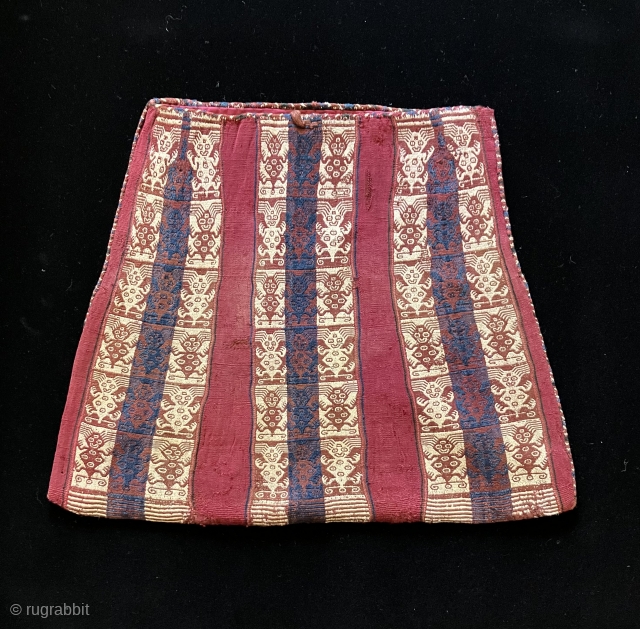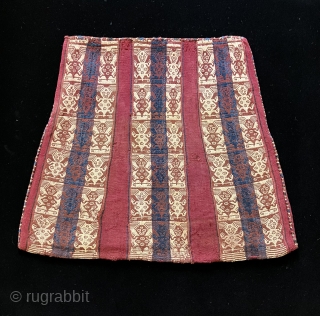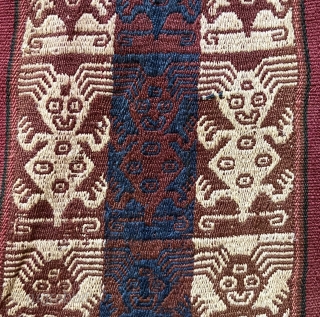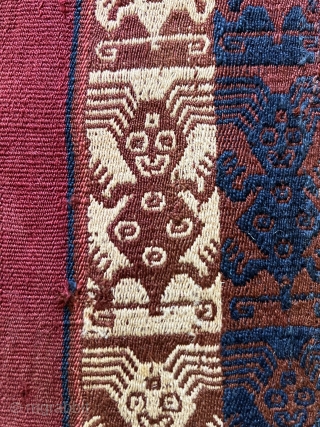Back
Classic Chiribaya Coca bag. This large bag with a pronounced flared shape is in my experience a great example of the weaving arts from the far s. of Peru and the far n. of Chile. It was likely woven by Tiwanaku descendants, Aymara speakers who settled in two valleys near the present-day Peru/Chile border. On the Peruvian side in the Algarrobo Valley near the port of Ilo, Moquegua, and on the Chilean side in the Azapa Valley near Arica. The bag was made between a.d. 900 - a.d. 1400 - the period directly proceeding the Inca conquest of the region. The bag is exceedingly fine, thin and supple. It was expertly woven using fine two-ply alpaca yarns in a warp-faced plain weave with complimentary warp patterning. Its distinctive trapezoidal shape was achieved by adding virtually undetectable supplemental warps as the weaving progressed. The design consists of vertical rows of stylized anthropomorphic male figures with rayed appendages sprouting from their heads. They display large eyes, U-shaped (grinning) mouths, raised hands with three fingers and circular designs in their trunk. These figures may represent supernatural beings and/or a shaman in an ecstatic trance state. Archaeological evidence provides us with some information about this culture, which had two distinct social classes. Members of the lower one were buried in simple pits with only a few grave goods and plain textiles, while those of the more elite group were buried in rectangular tombs with highly decorated ceramics and fine quality textiles like this example. Coca bags (ch’uspas) such as this one held special importance in male tombs, with up to nine found in a single tomb, some containing coca leaves. Other textiles found include loincloths, hats, belts and small rectangular ritual textiles as well as larger mantles and shaped tunics. The Chiribaya Culture collapsed around 1350 a.d. after a catastrophic El Niño period that destroyed their settlements and irrigation systems. This bag has been in several important collections over the years and was recently acquired from a excellent collection of Andean bags. It is significantly larger than most bags of the type. Measurements: 12 inches deep x 10 wide (top) x 15 inches wide (bottom).
price:
Contact directly - jameswblackmon@gmail.com
- Home
- Antique Rugs by Region
- Category
- Profiles
- Post Items Free
- Albums
- Benaki Museum of Islamic Art
- Budapest: Ottoman Carpets
- Gulbenkian Museum
- Islamic Carpets. Brooklyn
- Islamic Textiles. Brooklyn
- Konya Museum: Rugs
- MKG, Hamburg
- MMA: Caucasian Carpets
- MMA: Mamluk Carpets
- MMA: Mughal Indian Carpets
- MMA: Ottoman Carpets
- MMA: Safavid Persian Carpets
- MMA: Turkmen Rugs
- McCoy Jones Kilims
- Ottoman textiles. Met
- Philadelphia Museum
- Rugs and Carpets: Berlin
- Seljuqs at the Met
- TIEM, Istanbul: Carpets
- V&A: Classical Carpets
- Vakiflar Carpets: Istanbul
- Baluch Rugs: Indianapolis
- Gallery Exhibitions
- Jaf an Exhibition
- Alberto Levi Gallery
- Andean Textile
- Christie's London: 2016
- Francesca Galloway
- HALI at 40
- ICOC Washington, DC 2018
- Jajims of the Shahsavan
- London Islamic Week April, 2018
- Mongolian Felts
- Navajo Rugs: JB Moore
- Persian Piled Weavings
- SF Tribal & Textile Art Show 2020
- SF Tribal 2019
- Sotheby's: C. Alexander
- Turkish Prayer Rugs
- Turkmen Main Carpets ICOC 2007













